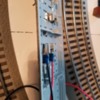Currently have a TIU connected to a lionel 180 Brick going to 1 spot. Trains crap out of power in 3rd inside loop after the switch. How many different spots do I need to connect for this layout and whats the easiet way to do? Do I need a MTH terminal block?
Replies sorted oldest to newest
Try adding feeder wires or solder tracks together.I add feeder wires every 10 feet.
I'll second the recommendation for every 10'. Use a good sized wire, ideally 14ga. You can solder it directly to the power tabs under neath the fastrack, each piece has them.
I see your running DCS as well. You'll probably want to put your layout into blocks as well. I'd put a break in the center rail on each end of 10' of track with feeders at the center of each section.
You should also run those feeder wires back to an MTH terminal block fed by the TIU for the best DCS operation.
Legacy does not have a "preferred "wiring style. Wire your layout for DCS and add the Legacy command wire to the common input on the terminal block.
Heres a link to other DCS wiring topics for more info: DCS Wiring
I talked to MTH and he said to run the engine on the app around and check the amps and see where its low then based on that I can either add a lockon in that vicinity to help out. He said the 180 Lionel should be enough to do my 8x12 layout. I really dont want to solder anything in case I change the layout later which is probably what I will do.
Like this https://www.youtube.com/watch?v=fuStJoh5Fv4 ???
The brick has plenty of power, its not the issue. The issue is getting that power to the track which means larger wire and multiple feeders.
I understand you may change the layout. You can still solder, 3 seconds with a hot iron on soldered wire will release it from the track.
The idea is to do the wiring right the first time. If you put feeders up spaced periodically there will be no deadspots to chase and you can get on to the buisness of running trains.
You'll also want those feeders for reliable DCS operation. Check out some of the threads I posted in the link above.
Wiring is the most important thing next to trackwork for reliable running. A little extra work now will save you tons of aggravation later.
I tested the track with the MTH ALP 46 and it is giving me 16.50-16.89 around the track Voltage and signal is 8-10 everywhere? Do I have to do anything further? Also how would I use thicker wire and attach to fastrack?
I use these (I think they are called 110 connectors) instead of soldering. You just crimp them on the wire and then connect them to the bottom of the Fastrack, run the wire through a hole in the table beneath the track and attach to power. I have them every 4 feet or so, probably overkill, but it works.
Attachments
Then are they going to a the MTH TERMINAL?
Robert Cushman posted:Then are they going to a the MTH TERMINAL?
Do like Battrain says. You can connect the two wires from the Fastrack to a small terminal block mounted underneath the layout at each feeder/drop and then run your power wires from the 12-24 MTH terminal block to each small terminal block. No soldering required.
However, note that I have a  TVS suppressor soldered to each small terminal block for safety.
TVS suppressor soldered to each small terminal block for safety.
Attachments
What size wire is that? Is that solid wire or stranded?
Robert Cushman posted:What size wire is that? Is that solid wire or stranded?
The yellow and green wires are 16 gauge stranded wire from the .110 connectors underneath the Fastrack to the terminal block, as shown. I used red/black paired 14 gauge stranded wire from the MTH terminal block to the track block. Wire was purchased from Del City Electronics.
RichieC, excuse my ignorance, I don't have a layout now buy hope to some day. What is the reason for the TVS resistor for safety? TIA!
Today's train systems use sophisticated electronics that are expensive and can be sensitive to things like electrical shorts and derailments (which are inevitable). The TVS suppressors help protect those sensitive electronics. They can degrade over time when they are called into play and do their job, so some people replace them every few years. IMHO they're easy to install and cheap insurance - like fast acting fuses.
If you do a search on the Forum, you'll find a more technical breakdown of how they work.














